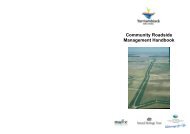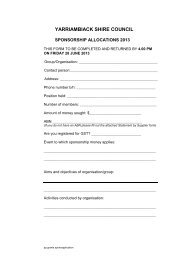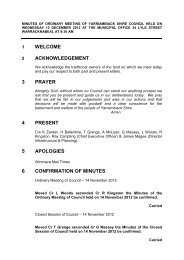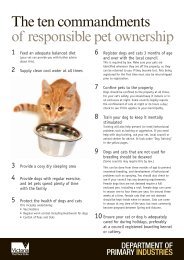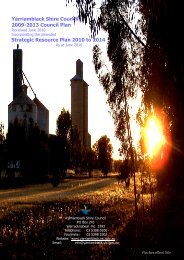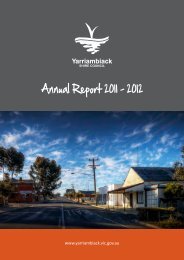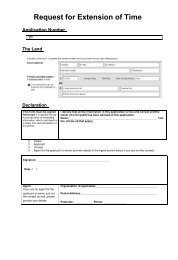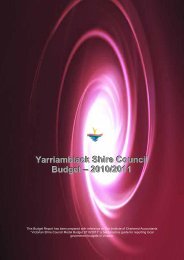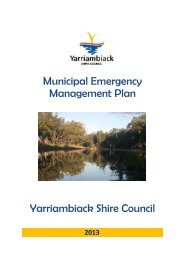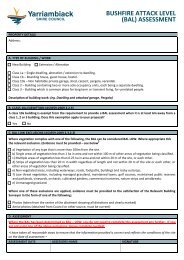2010 - Yarriambiack Council
2010 - Yarriambiack Council
2010 - Yarriambiack Council
- No tags were found...
Create successful ePaper yourself
Turn your PDF publications into a flip-book with our unique Google optimized e-Paper software.
NOTES TO THE ACCOUNTS<br />
Note 36 Financial Instruments (continued)<br />
c) Net Fair Values<br />
The aggregate net fair values of financial assets and financial liabilities, both recognised and<br />
unrecognised, at balance date, are as follows:<br />
Financial Instruments<br />
Total carrying amount as<br />
per Balance Sheet<br />
<strong>2010</strong> 2009<br />
$’000 $’000<br />
Aggregate net fair value<br />
<strong>2010</strong><br />
$’000<br />
2009<br />
$’000<br />
Financial Assets<br />
Cash and cash equivalents 8,422 7,028 8,422 7,028<br />
Trade and other receivables 635 655 635 655<br />
Total Financial Assets 9,057 7,683 9,057 7,683<br />
Financial Liabilities<br />
Trade and other payables 861 978 861 978<br />
Interest – bearing loans and<br />
borrowings 350 407 341 407<br />
Total Financial Liabilities 1,211 1,385 1,202 1,385<br />
d) Credit risk<br />
The maximum exposure to credit risk at balance date in relation to each class of recognised financial<br />
assets is represented by the carrying amount of these assets as indicated in the Balance Sheet.<br />
e) Risks and mitigation<br />
The risks associated with our main financial instruments and our policies for minimising these risks<br />
are detailed below.<br />
Market risk<br />
Market risk is the risk that the fair value or future cash flows of our financial instruments will fluctuate<br />
because of changes in market prices. The <strong>Council</strong>’s exposures to market risk are primarily through<br />
interest rate risk with only insignificant exposure to other price risks and no exposure to foreign<br />
currency risk. Components of market risk to which we are exposed are discussed below.<br />
Interest rate risk<br />
Interest rate risk refers to the risk that the value of a financial instrument or cash flows associated<br />
with the instrument will fluctuate due to changes in market interest rates. Interest rate risk arises<br />
from interest bearing financial assets and liabilities that we use. Non derivative interest bearing<br />
assets are predominately short term liquid assets. Our interest rate liability risk arises primarily from<br />
long term loans and borrowings at fixed rates which expose us to fair value interest rate risk.<br />
Our loan borrowings are sourced from major Australian banks. Overdrafts are arranged with major<br />
Australian banks. We manage interest rate risk on our net debt portfolio by:<br />
• ensuring access to diverse sources of finding;<br />
• reducing risks of refinancing by managing in accordance with target maturity profiles; and<br />
• setting prudential limits on interest repayments as a percentage of rate revenue.<br />
We manage the interest rate exposure on our net debt portfolio by appropriate budgeting strategies<br />
and obtaining approval for borrowings from the Australia Loan <strong>Council</strong> each year.<br />
Investment of surplus funds is made with approved financial institutions under the Local Government<br />
Act 1989. We mange interest rate risk by adopting an investment policy that ensures:<br />
• conformity with State and Federal regulations and standards,<br />
• adequate safety,<br />
Annual Report 2009/10 75



